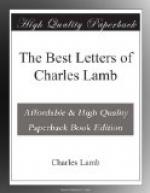It was under the quickening influence of the eloquent, precocious genius of the “inspired charity boy” that Charles Lamb’s ideals and ambitions shaped themselves out of the haze of a child’s conceptions. Coleridge at sixteen was already a poet, his ear attuned to the subtlest melody of verse, and his hand rivalling, in preluding fragments, the efforts of his maturer years; he was already a philosopher, rapt in Utopian, schemes and mantling hopes as enchanting—and as chimerical—as the pleasure-domes and caves of ice decreed by Kubla Khan; and the younger lad became his ardent disciple.
Lamb quitted Christ’s Hospital, prematurely, in November, 1787, and the companionship of the two friends was for a time interrupted. To part with Coleridge, to exchange the ease and congenial scholastic atmosphere of the Hospital for the res angusta domi, for the intellectual starvation of a life of counting-house drudgery, must have been a bitter trial for him. But the shadow of poverty was upon the little household in the Temple; on the horizon of the future the blackening clouds of anxieties still graver were gathering; and the youngest child was called home to share the common burden.
Charles Lamb was first employed in the South Sea House, where his brother John [3]—a cheerful optimist, a dilettante in art, genial, prosperous, thoroughly selfish, in so far as the family fortunes were concerned an outsider—already held a lucrative post. It was not long before Charles obtained promotion in the form of a clerkship with the East India Company,—one of the last kind services of Samuel Salt, who died in the same year, 1792,—and with the East India Company he remained for the rest of his working life.
Upon the death of their generous patron the Lambs removed from the Temple and took lodgings in Little Queen Street, Holborn; and for Charles the battle of life may be said to have fairly begun. His work as a junior clerk absorbed, of course, the greater part of his day and of his year. Yet there were breathing-spaces: there were the long evenings with the poets; with Marlowe, Drayton, Drummond of Hawthornden, and Cowley,—“the sweetest names, which carry a perfume in the mention;” there were the visits to the play, the yearly vacation jaunts to sunny Hertfordshire. The intercourse with Coleridge, too, was now occasionally renewed. The latter had gone up to Cambridge early in 1791, there to remain—except the period of his six months’ dragooning—for the nest four years. During his visits to London it was the habit of the two schoolfellows to meet at a tavern near Smithfield, the “Salutation and Cat” to discuss the topics dear to both: and it was about this time that Lamb’s sonnet to Mrs Siddons, his first appearance in print, was published in the “Morning Chronicle.”
The year 1796 was a terribly eventful one for the Lambs. There was a taint of insanity in the family on the father’s side, and on May 27, 1796, we find Charles writing to Coleridge these sad words,—doubly sad for the ring of mockery in them:—




